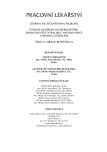An unusual radiograph lung finding in a welder – a case study
Authors:
Kadeřábková O.ihash2ihash4ihash6ihash8ihash10 1 1 1 1 2 3
Authors‘ workplace:
Klinika pracovního lékařství, LF UK a FN, Plzeň, přednostka as. MUDr. Vendulka Machartová, Ph. D.
1; Radiodiagnostické oddělení FN Plzeň, přednosta prim. MUDr. Zdeněk Chudáček, Ph. D.
2; Ústav klinické biochemie a hematologie, LF UK a FN, Plzeň, přednosta prof. MUDr. Jaroslav Racek, DrSc.
3
Published in:
Pracov. Lék., 63, 2011, No. 3-4, s. 147-151.
Category:
Case Studies
Overview
Authors present a case study of a 31 year old welder with an unusual radiograph lung finding within the basic diagnosis of asthma bronchiale. The patient was examined for breathing troubles at the outpatient department of the clinic of occupational diseases. The deposits of metal mercury were proved in lungs and in the right heart. The radiograph finding indicated evaluation of the concentration of mercury in blood and urine samples. All samples showed significantly increased concentrations (Hg in blood up to 130 μg/l, Hg in urine up to 420 μg/l). The patient has not shown any signs of chronic mercury intoxication, in the course of the monitored period the clinical and radiograph findings have been stable, the mercury concentration in blood and urine has dropped after 3 years. The patient has not come to the control examination. We learnt from the general practitioner that the patient died due to dilatation cardiomyopathia proved by an autopsy. The etiology of the finding has not been clarified. Presumably it was a lung embolus caused by an i.v. application of mercury. The patient approved an i.v. application of drugs (Pervitin) with the aim of increasing work efficiency.
Key words:
welder, metal mercury, deposits in lungs, mercury in blood, mercury in urine
Sources
1. DUS, M. J. L., VIEDMA, E. C., BRAVO, J., GUTIÉRREZ, A., BAYO, L., ALDÁS, J. L. Pulmonary Embolism Cause by Elemental Mercury. Arch. Broncopneumol., 2007, 43, 10, s. 585–587.
2. CHITKARA, R., SERIFF, N. S., KINAS, H. Y. Intravenous self-administration of Metallic Mercury in Attempted suicide. Report of a case with serial roentgenographic and physiologic studies over an 18-month period. Chest, 1978, 73, s. 234–236.
3. GIVICA-PERÉZ, A., SANTANA-MONTESDEOCA, J. M., DIAZ-SÁNCHEZ, M., MARTINÉZ-LAGARES, F. J., CASTANEDA, W. R. Repeated self-administration of metallic Mercury injection: case report and review of the literature. Eur. Radiol., 2001, 11, s. 1351–1354.
4. KONOPKA, T., NALEPA, P., RZEPECKA-WOZNIAK, E. Long-term survival after a suicidal intravenous injection of Mercury. Arch. Med. Sad. Krym., 2006, LVI, s. 267–270.
5. MC FEE, R. B., CARACCIO, T. R. Intravenous Mercury Injection and Ingestion: Clinical Manifestations and. Management. Clinical Toxikology, 2001, 39, 7, s. 733–738.
6. PETERSON, N., HARVEY-SMITH, W., ROHRMANN, CH. A., Jr. Radiographic Aspects of Metallic Mercury Embolism. American Roentgen Ray Society, 1980, 135, s. 1079–1081.
7. SHAREEFF, M., BHAT, Y. M., ADABALA, R., RAOOF, S. Shortness of Breath After Suicide Attempt. Chest, 2000, 118, s. 837–838.
8. STAHL, M. G., BONEKAT, H. W., SHIGEOKA, J. W. Concomitant Pulmonary Tromboembolism and Metallic Mercury Embolism. A diagnostic dilemma. Chest, 1985, 88, s. 787–789.
9. VAS, W., TUTTLE, J. R., ZYLAK, C. J. Intravenous Self-Administration of Metallic Mercury. Radiology, 1980, 137, s. 313–315.
10. WINKER, R., SCHAFFER, A. W., KONNARIS, C., BARTH, A., GIOVANOLI, C., OSTERODE, P. W., RÜDIGER, H. W., WOLF, C. Health consequenses of an intravenous injection of metallic Mercury. Int. Arch. Occup. Environ. Health, 2002, 75, s. 581–586.
Labels
Hygiene and epidemiology Hyperbaric medicine Occupational medicineArticle was published in
Occupational Medicine

2011 Issue 3-4
Most read in this issue
- Limitations in patients with vertebral pathology
- Mental load in nurses taking care for oncological patients
- An unusual radiograph lung finding in a welder – a case study
- Professional musicians and occupational diseases – a case study
